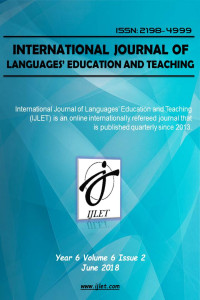Abstract
Writing is regarded as the most challenging task and the most difficult language skill among EFL students. Students need to employ different cognitive strategies in order to convey the meaning to the reader. Due to the complexity of the process, students display negative attitudes towards writing and the level of success is low. This study investigates B2 level creative writing and its impact on the success level of students in academic writing. The study included 15 students, 10 of them are females (%66,7) and 5 of them are males (%33,3). The t-test results obtained from midterm and final exams indicate that students’ success level improves in academic writing skills. Participants’ pretest and post test results revealed that creative writing help them develop critical thinking skills and when SCAMPER method is used, students’ problem solving skills are promoted.
References
- Amabile, M. T. (1988). A Model of Creativity and Innovation in Organizations. Research In Organizational Behavior, 10(1), 123-167.
- Amabile, M.T. (1996). Creativity in Context. Boulder, CO: Westfield Press.
- Babaee, R. (2015). Interview with Alan Maley on Teaching and Learning Creative Writing. International Journal of Comparative Literature and Translation Studies, 3(3), 77-81.
- Bilton, L., & Sivasubramaniam, S. (2009). An inquiry into expressive writing: A classroom-based study. Language Teaching Research, 13(3), 301-320.
- Bishop, W. (1993). Crossing the lines: On creative composition and composing creative writing. Writing on the Edge, 4(2), 117-133.
- Cropley, A. J. (1997). Fostering creativity in the classroom: General principles. The creativity research handbook, 1(84.114).
- Kırkgöz, Y. (2014). Exploring poems to promote language learners’ creative writing. Procedia-Social and Behavioral Sciences, 158, 394-401.
- Lucas, B. (2001). Creative teaching, teaching creativity and creative learning. Creativity in education, 35-44.
Abstract
References
- Amabile, M. T. (1988). A Model of Creativity and Innovation in Organizations. Research In Organizational Behavior, 10(1), 123-167.
- Amabile, M.T. (1996). Creativity in Context. Boulder, CO: Westfield Press.
- Babaee, R. (2015). Interview with Alan Maley on Teaching and Learning Creative Writing. International Journal of Comparative Literature and Translation Studies, 3(3), 77-81.
- Bilton, L., & Sivasubramaniam, S. (2009). An inquiry into expressive writing: A classroom-based study. Language Teaching Research, 13(3), 301-320.
- Bishop, W. (1993). Crossing the lines: On creative composition and composing creative writing. Writing on the Edge, 4(2), 117-133.
- Cropley, A. J. (1997). Fostering creativity in the classroom: General principles. The creativity research handbook, 1(84.114).
- Kırkgöz, Y. (2014). Exploring poems to promote language learners’ creative writing. Procedia-Social and Behavioral Sciences, 158, 394-401.
- Lucas, B. (2001). Creative teaching, teaching creativity and creative learning. Creativity in education, 35-44.
Details
| Primary Language | English |
|---|---|
| Subjects | English As A Second Language |
| Journal Section | Research Article |
| Authors | |
| Publication Date | June 30, 2018 |
| Published in Issue | Year 2018 Volume: 6 Issue: 2 |


